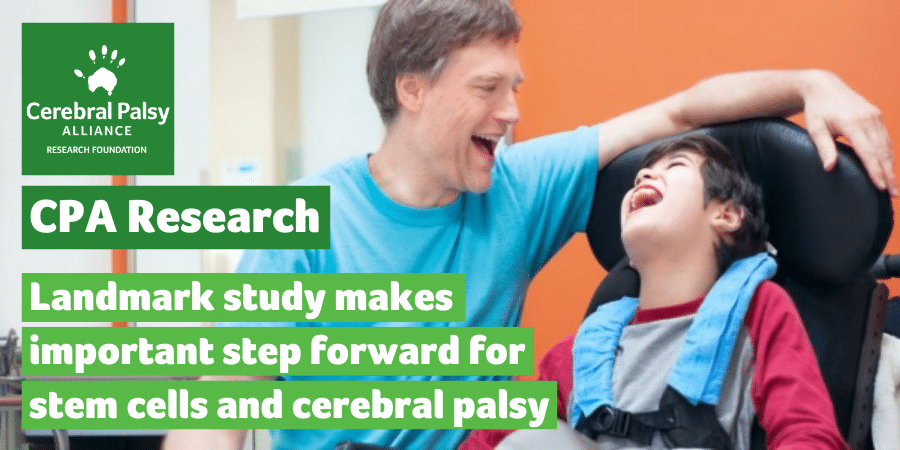
At a glance:
An Australian-first study has found that collecting and storing cells from a baby’s umbilical cord blood and later transferring them to a sibling who has cerebral palsy is safe.
Cerebral palsy is caused by damage to the developing brain while in utero, during birth or in the first years of life. The congenital disorder affects around two per 1000 live births across the world, making it the most common physical disability in childhood. An Australian child is born with cerebral palsy every 20 hours.
The clinical trial, led by the Murdoch Children’s Research Institute (MCRI) and published in Cytotherapy, stated fully matched umbilical cord blood cells from one child could safely be infused into a sibling with cerebral palsy. The study was funded by the Cerebral Palsy Alliance Research Foundation and Cell Care cord blood bank.
The phase I clinical trial involved 12 participants, aged 1-16 years, from across Australia who received a sibling’s cord blood cells and were followed up for 12 months after the infusion.
Only one serious adverse reaction related to the study treatment was reported which was treated effectively in hospital. The vast majority of adverse reactions reported were mild, and deemed to be not, or unlikely, related to the study.
MCRI researcher Dr Kylie Crompton said while there was no cure for cerebral palsy, cord blood cells have the potential to improve brain injury and gross motor function because of their ability to activate repair processes and regenerate some tissues in the human body.
“Our study found infusing matched sibling cord blood cells into children with cerebral palsy is a relatively safe procedure however it should only be conducted in tertiary hospitals with facilities to treat the infrequent adverse reactions,” she said.
Most of the participants, monitored for a year, showed typical developmental progress for children with cerebral palsy. Improvements in gross motor function were noted in three children, three months after the infusion. Any changes were less pronounced one year afterwards. Dr Crompton said the greatest gross motor improvements were seen in younger children.
“This suggests that intervention may be more effective in the first few years of life. To find out if this is the case, we and other researchers are now planning additional trials to understand these effects better.”
MCRI’s Professor Dinah Reddihough said the findings were a valuable stepping-stone towards establishing the safety and feasibility of using umbilical cord blood in the management of cerebral palsy. However, not all children with cerebral palsy will have fully matched siblings’ cells available.
“Investigating a cell product that is available to the broader cerebral palsy community, rather than just those with matched siblings who have cord blood stored, is an important next step. Further research is also needed to investigate whether different forms of cerebral palsy are more amenable to change following cord blood cell infusion, what cell dose is required and if multiple doses would provide a better outcome.”
Diagnosed with cerebral palsy, Charlotte at age two couldn’t grip a water bottle or pen, verbally communicate and was yet to take her first steps. After taking part in the trial, mum Laura West said it was like “a light switch had been turned on.”
While pregnant with her youngest daughter, Emma, Laura decided to collect and store cells from her umbilical cord to have them later infused to Charlotte. Laura accessed Cell Care’s cord blood collection and storage program for siblings of a child with cerebral palsy. The free program ensures these stem cells are collected in a fully audited and government-approved manner so that they will be available for use in future clinical trials in Australia.
Laura said the changes in Charlotte, now aged seven, were evident after starting the cell infusion.
“Charlotte was quite static in her development and progress up until the infusion and then we saw this noticeable difference,” she said.
“It was striking at first and then settled into a steady improvement. Charlotte was always fed through a tube but quickly learned to drink out of a bottle. We never thought she would be able to grip a pencil properly but then suddenly she was holding it correctly.
“She went from being propped up with pillows to sitting, standing and running. It was huge to see her so independent and able to do these things by herself. The rate of change in Charlotte in the immediate aftermath was so pronounced but now her development has slowed to baby steps.
“We’re glad the researchers will continue the work to see if the intervention may be more effective in the first few years of life, which will offer hope to other families.”
Professor Nadia Badawi, Cerebral Palsy Alliance Chair of Cerebral Palsy Research at The University of Sydney, said this was a landmark study, which gave a new understanding of how umbilical cord blood cells might one day be used to improve the lives of children with cerebral palsy.
“We are indebted to the children and their families who participated in this research, and who have helped to pave the way for many future trials,” she said.
“At Cerebral Palsy Alliance, we are committed to carrying out research that empowers people with cerebral palsy and their families. From surveying our community, we know that people with cerebral palsy and their families want more research into potential therapies, and this study is an important step forward in demonstrating the safety of using cord blood cells in an Australian hospital setting.”
Find out more about how stem cells can move out of the lab and into standard medical care
Researchers from The Royal Children’s Hospital, University of Melbourne, Cerebral Palsy Alliance Research Institute, Monash Children’s Hospital, Monash University, The Children’s Hospital at Westmead, Queensland Children’s Hospital, The University of Queensland, Royal Brisbane and Women’s Hospitals, Starship Children’s Hospital in Auckland and the University of Auckland also contributed to the study.